Scrum傻瓜实操手册-李晶
- 格式:pdf
- 大小:1.69 MB
- 文档页数:23
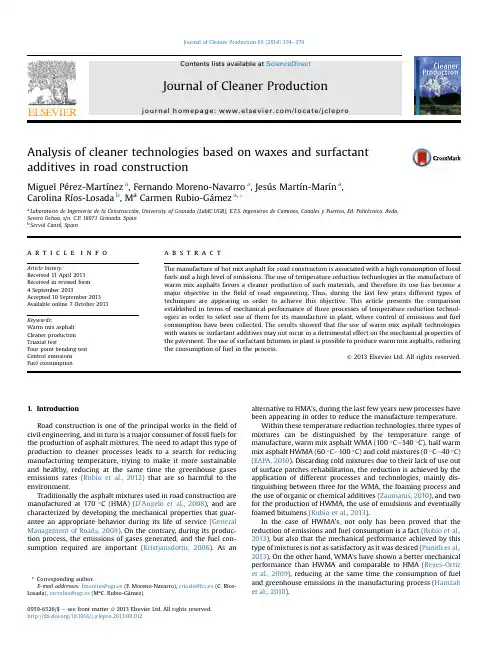
Analysis of cleaner technologies based on waxes and surfactant additives in road constructionMiguel Pérez-Martínez a,Fernando Moreno-Navarro a,Jesús Martín-Marín a,Carolina Ríos-Losada b,M a Carmen Rubio-Gámez a,*a Laboratorio de Ingeniería de la Construcción,University of Granada(LabIC.UGR),E.T.S.Ingenieros de Caminos,Canales y Puertos,Ed.Politécnico,Avda. Severo Ochoa,s/n,C.P.18071Granada,Spainb ServiàCantó,Spaina r t i c l e i n f oArticle history:Received11April2013 Received in revised form4September2013Accepted10September2013 Available online7October2013Keywords:Warm mix asphaltCleaner productionTriaxial testFour point bending testControl emissionsFuel consumption a b s t r a c tThe manufacture of hot mix asphalt for road construction is associated with a high consumption of fossil fuels and a high level of emissions.The use of temperature reduction technologies in the manufacture of warm mix asphalts favors a cleaner production of such materials,and therefore its use has become a major objective in thefield of road engineering.Thus,during the last few years different types of techniques are appearing in order to achieve this objective.This article presents the comparison established in terms of mechanical performance of three processes of temperature reduction technol-ogies in order to select one of them for its manufacture in plant,where control of emissions and fuel consumption have been collected.The results showed that the use of warm mix asphalt technologies with waxes or surfactant additives may not incur in a detrimental effect on the mechanical properties of the pavement.The use of surfactant bitumen in plant is possible to produce warm mix asphalts,reducing the consumption of fuel in the process.Ó2013Elsevier Ltd.All rights reserved.1.IntroductionRoad construction is one of the principal works in thefield of civil engineering,and in turn is a major consumer of fossil fuels for the production of asphalt mixtures.The need to adapt this type of production to cleaner processes leads to a search for reducing manufacturing temperature,trying to make it more sustainable and healthy,reducing at the same time the greenhouse gases emissions rates(Rubio et al.,2012)that are so harmful to the environment.Traditionally the asphalt mixtures used in road construction are manufactured at170 C(HMA)(D’Angelo et al.,2008),and are characterized by developing the mechanical properties that guar-antee an appropriate behavior during its life of service(General Management of Roads,2008).On the contrary,during its produc-tion process,the emissions of gases generated,and the fuel con-sumption required are important(Kristjansdottir,2006).As an alternative to HMA’s,during the last few years new processes have been appearing in order to reduce the manufacture temperature.Within these temperature reduction technologies,three types of mixtures can be distinguished by the temperature range of manufacture,warm mix asphalt WMA(100 C e140 C),half warm mix asphalt HWMA(60 C e100 C)and cold mixtures(0 C e40 C) (EAPA,2010).Discarding cold mixtures due to their lack of use out of surface patches rehabilitation,the reduction is achieved by the application of different processes and technologies,mainly dis-tinguishing between three for the WMA,the foaming process and the use of organic or chemical additives(Zaumanis,2010),and two for the production of HWMA,the use of emulsions and eventually foamed bitumens(Rubio et al.,2013).In the case of HWMA’s,not only has been proved that the reduction of emissions and fuel consumption is a fact(Rubio et al., 2013),but also that the mechanical performance achieved by this type of mixtures is not as satisfactory as it was desired(Punith et al., 2013).On the other hand,WMA’s have shown a better mechanical performance than HWMA and comparable to HMA(Reyes-Ortiz et al.,2009),reducing at the same time the consumption of fuel and greenhouse emissions in the manufacturing process(Hamzah et al.,2010).*Corresponding author.E-mail addresses:fmoreno@ugr.es(F.Moreno-Navarro),crioslo@fcc.es(C.Ríos-Losada),mcrubio@ugr.es(M a C.Rubio-Gámez).Contents lists available at ScienceDirect Journal of Cleaner Productionjournal homep age:www.elsevi/locate/jclepro0959-6526/$e see front matterÓ2013Elsevier Ltd.All rights reserved./10.1016/j.jclepro.2013.09.012Journal of Cleaner Production65(2014)374e379Based on the number of advantages associated to WMA mix-tures(D’Angelo et al.,2008),which result in environmental(lower emissions),economical(cost savings and lower energy consump-tion)and constructional benefits(better workability and larger compaction window,greater hauling distances and less opening time to traffic)this research compare three WMA technologies for reducing the manufacture temperature of conventional hot mix asphalts.Thefirst is one of the most common additives used for this purpose,the organic waxes,which are aliphatic hydrocarbons of long-chain produced by the Fischer e Tropsch process(Wax,2005). Meanwhile as growing alternative,surfactant additives are an en-ergetic reducing agent allowing the manufacture of WMA to a reduced temperature while maintaining their mechanical proper-ties,the addition was considered in two different ways,mixing the bitumen and the surfactant in plant before adding to the mixture (dry process),and a surfactant modified bitumen(wet process) blended in refinery to compare their influence.This paper shows a laboratory level characterization of an asphalt concrete AC16S mixture for the surface course(EN13108-1,2008)under three temperature reduction technologies.Based on the results obtained,one of the mixtures was chosen to adapt a HMA plant for the production of WMA mixtures and measure the emissions and fuel consumption during the manufacturing boratory works on the mixtures was based on Marshall test,water sensitivity test,triaxial test and four point bending test established the parameters to select the most appropriate mixture for being produced at bigger scale.During the manufacturing process in plant measurement of the emis-sions and fuel consumption of a HMA and the WMA were taken. Finally,the main the conclusions obtained from the analysis of results are exposed.2.Materials and methods2.1.Materials2.1.1.AggregatesAn AC16S(EN13108-1)mixture,which is found in roads and highways all over the world,was used to carry out the study.The aggregates were porphyry for the coarse fraction(12/18and6/12),and a combination of porphyry(0/6)and limestone(0/4)for the fine fraction.Moreover,thefiller employed was calcium carbonate. Table1lists the aggregate properties.The aggregates combination by percentage is shown in Table2, where the gradation of the mixture(Fig.1)was kept constant for all the mixtures developed at lower temperature and with different additives.2.1.2.BitumensFour different binders have been used for the attainment of the objectives of the investigation.Thefirst binder used was conven-tional50/70,and besides being used alone,it was the base for the other three bitumens.50/70bitumen,modified with an organic surfactant additive was used as second binder in order to improve its workability at lower temperatures.The bitumen modification was made in labo-ratory and the percentage of additive used was chosen following the manufacturer recommendations(1%over bitumen weight).The third one was modified50/70bitumen with surfactant products to improve the wettability of the binder as an alterna-tive to the conventional for the reduction of temperature.The last binder used was50/70bitumen modified with microcrys-talline waxes produced by the Fischer e Tropsch process as addi-tive.In both cases,the bitumen was modified in refinery.Table3 describes all the mixtures designed and the additives used,as well as the temperature reduction applied on their manufacture process.2.2.MethodologyThe methodology followed is composed of two phases,labora-tory works and the manufacturing industrial process in plant,being thefirst one divided in three steps and focused on the analysis of the working formula for its adaptation to the manufacture process under different temperature reduction technologies.And the sec-ond one based on the adaptation of a hot mix asphalt plant for the production of a warm asphalt mixture.In laboratory,firstly the optimum bitumen content needs to be determined for the conventional mixture of reference without additives.Based on the values of air voids(%),deformation(mm) and stability(kN)of the Marshall test(NLT-159,2000)the optimumTable1Reference values of the aggregates and mineral dust.Test/aggregate type Coarse aggregate Fine aggregate FillerGrain size(EN933-1)/(EN933-10)Sieves(mm)12/18Porphyry6/12Porphyry0/6Porphyry0/4Limestone Carbonate(CaCO3)24.4100100100100e1684100100100e8162100100e4158792e21160681000.51129301000.251121201000.125e e e e970.0630.50.911.81187Sand equivalent(EN933-8)(>50)4554Bulk density(EN-1097-3)(0.5e0.8Mg/m3)0.7Percentage of fractured face(EN933-5)(100%)100100Flakiness index(EN933-3)(25)1625Resistance to fragmentation(EN1097-2)(20)1515Cleaning(organic impurity content)(UNE146130,Annex C)(0.5%)0.50.5Particle density andabsorption(EN1097-6)r a(Mg/m3) 2.73 2.73 2.77 2.71r SSD*(Mg/m3) 2.70 2.71 2.72 2.67r RD(Mg/m3)2.69 2.70 2.70 2.65Water absorption after immersion(%)0.600.400.910.77M.Pérez-Martínez et al./Journal of Cleaner Production65(2014)374e379375content of binder was set,using the same in all the WMA ’s mix-tures.Furthermore,several test were carried out to assess the mechanical behavior of the conventional mix:water sensitivity test (EN 12697-12,2009),cyclic triaxial compression test (EN 12697-25,2006,method B)in order to study the plastic deformations,and the four point bending fatigue cracking test (EN 12697-24,2013,annex D)to assess the long term response of the mixture.In the second stage the Marshall test,with the optimum bitumen content determined,is undertaken for the three mixtures with temperature reduction technology at 140 C to study their Marshall stability (kN),voids content (%)and deformation (mm).The mechanical performance was also evaluated in the WMA mixtures applying the same test procedures and conditions as in the first stage for the Reference Mix.Finally,a comparative analysis of the four mixtures is developed.With this purpose their stability (kN),retained strength against water (%),creep modulus (MPa)and fatigue life parameters are compared.Based on this analysis,the warm mix asphalt technology with the best overall performance will be selected for its adaptation to the plant production and to construct a road section test.In plant works are centered on the adaptation of a HMA plant for the manufacture of a WMA mixture.For this purpose a HMA and WMA mixtures are produced,measuring during the process the emission of pollutants,as well as the consumption of fuel required.In the case of the control of emissions,the methodology was similar to the one followed by Rubio et al.in (2013).In-point source emissions were measured (Fig.2);humidity,wind,and temperature data were also collected to assure the spreading in similar atmospheric conditions for HMA and WMA gases to compare the results.The parameters evaluated were the Combustion Gases (CO,NO x ,O 2,CO 2)measured by a multi-parameter analyzer (TESTO MXL),the Total Organic Carbon (TOC)through a flame ionization detector (FID,M&A PT)and the emission of Particles (collected in a 47mm filter and subsequently calculated in the laboratory by gravimetry).To complete the investigation,the consumption of fuel used is also measured.3.Analysis of results 3.1.Marshall testThe Marshall test results in regards to the optimum bitumen content is shown in Table 4.As can be seen,the values of me-chanical resistance developed by the mixtures in terms of stability and deformation are slightly lower in the case of warm mix as-phalts produced at lower temperature.Furthermore,in the case of surfactants additives (both dry and wet process)a decrease in terms of density is attained by the mixtures as well as an increased in the air voids content.This is due to this type of additives,which produce an improvement in the adhesiveness aggregate/binder and a better wetting of the aggregate,but no change in the viscosity of the bitumen,and therefore it may have certain dif ficulties associ-ated to perform the compaction of the mixture at lower tempera-ture.In the case of wax bitumen,this fact does not occur as waxes modi fied binder viscosity and consequently the values of density and air voids are not affected by reducing the temperature of manufacture and compaction.3.2.Water sensitivity testA new set of 6specimens per mixture using the optimum bitumen content were produced to perform the water sensitivityTable 3Studied mixtures and bitumens used.DenominationBitumenAdditive natureAddition processMixturemanufacture temperature ( C)Reference Mix 50/70Nonee 160Dry Surfactant Mix50/70þ1%additive Surfactant Dry 140Wet Surfactant MixSurfactantmodi fied 50/70Surfactant Wet 140Wet Wax MixWax modi fied 50/70Microcrystalline waxesWet140Fig.1.Aggregate gradation for asphalt mix type AC-16S.Table 2Aggregates combination by percentage.Aggregate fraction PercentagePorphyry 12/1815Porphyry 6/1244Porphyry 0/620Limestone 0/415Calcium carbonate filler6Fig.2.Simpli fied HMA plant distribution and in-point source.Table 4Marshall results and optimum bitumen content.ParameterReference Mix Drysurfactant Mix WetSurfactant Mix Wet Wax Mix Optimum bitumen content (%) 4.8 4.8 4.8 4.8Bulk density (kg/m 3)2423236423772437Marshall stability (kN)10.7079.4788.2049.053Marshall def.(mm) 2.3 2.9 3.5 3.7Vm (%) 4.0 5.1 4.6 3.1VMA (%)15.316.115.614.5M.Pérez-Martínez et al./Journal of Cleaner Production 65(2014)374e 379376test(EN12697-12,2009).Table5resumes the values of strength obtained in the test.Once again the resistance values,in this case indirect tensile strength,shown by warm mix asphalts are slightly lower than those of the Reference Mix,perhaps indicating that may be inter-esting to increase the energy of compaction when using this type of mixtures,but higher than the ones obtained by Oliveira et al.(2013) with and without rubber.However,the retained strength(ITSR) shown by warm mix asphalts is higher,and therefore can be considered that such materials will be less affected by the action of water.This is because,in the case of surfactant additived mixtures to the improvement of adhesiveness that they generate(not only improving the coating of the aggregate,but also acting as its stimulator).Meanwhile,in the Wet Wax Mix may be related to its compaction improvement and its lower void content.3.3.Cyclic triaxial compression testPlastic deformations were evaluated by the cyclic triaxial compression test(EN12697-25,2006,method B),taking at the same time the service stresses and strains into account by means of a confining load.The conditions selected involved the com-bined application at a constant temperature of40 C of a confining load of120kPa and another cyclic sinusoidal out-of-phase axial loading of300kPa at a frequency of3Hz during12,000load cycles.The creep modulus and permanent deformation parame-ters for each mix were calculated.Table6shows the triaxial test results.The values obtained for the creep modulus indicate that the most resistant mix against plastic deformations is the Wet Wax Mix.The Wet Surfactant Mix behaves similar to the Reference Mix, even manufactured at lower temperature and the permanent deformation experienced only varies in0.03%.In the case of the Dry Surfactant Mix,results showed an increase in plastic deformation, probably due to a lack of mix compaction(as it is showed in its void content).3.4.Four point bending testTo perform the test,specimens of408Â50Â50mm with sawn faces were manufactured,and a sinusoidal waveform load was applied.The tests were carried out at20 C,in strain control mode and at a frequency of10Hz.The mixtures were tested in six different strain amplitude levels,250m m/m;200m m/m;175m m/m; 150m m/m;125m m/m and100m m/m Fig.3shows the potential fatigue laws derived from the four-point bending test performed in the4types of mixtures tested.As can be observed,independently of the warm mix technology used,the fatigue behavior of the mixtures evaluated is very similar, which coincides with thefindings of other researchers(Jones et al., 2010).On the other hand,the correlation coefficients of the fatigue laws obtained are high,indicating a uniform mechanical behavior of the warm mix asphalts.This aspect agrees with the results ob-tained by Johnston et al.(2006),which showed that additive did not affect the homogeneity of its long-term mechanical behavior.Moreover,the fatigue behavior of the Dry and Wet Surfactant Mixes is very similar,regardless of the method used to add the additive.Meanwhile,it should be noted that the fatigue behavior of the Wet Wax Mix is slightly different.At higher strain amplitudes fatigue life is smaller,while for lower strain amplitudes it increases in relation to the other mixtures evaluated.This behavior is typical of more rigid materials,aspect which is supported by the results obtained in the triaxial test,where the Wet Wax Mix showed a low rate of permanent deformation(which means that is a more rigid material).Table6Triaxial test results.Parameter ReferenceMix DrySurfactantMixWetSurfactantMixWet WaxMixCreep modulus(MPa)178.57153.45175.95202.70Permanentdeformation(%)1.68 1.96 1.71 1.48Table5Water sensitivity test results.Parameter ReferenceMix Dry SurfactantMixWet SurfactantMixWet Wax MixITSR(kPa)dry group2030.01469.01749.71464.3ITSR(kPa)wet group1741.71281.01575.71357.3ITSR(%)85.587.290.192.7Fig.3.Fatigue behavior of the studied mixtures at strain controlled test(T¼20 C,f¼10Hz).M.Pérez-Martínez et al./Journal of Cleaner Production65(2014)374e3793773.5.Control of emissionsData collection for controlling emissions took place during the process of manufacturing the conventional HMA at 176 C and the mixture Wet Surfactant Mix selected as WMA at 140 C.Table 7resumes the results obtained.Fig.4shows the emissions results obtained from the manufacturing of WMA and HMA mixtures.They have been compared with the HMA and HWMA results from Rubio et al.(2013).In terms of CO 2and NO x WMA slightly reduces the emis-sions,while in TOC and CO the values obtained have been increased,which was not expected.It can be appreciated how HMWA reduce the emissions in comparison with the hot asphalt mix while no reduction is appreciated between the WMA and the hot asphalt mix.3.6.Fuel consumptionTable 8indicates the results from the measure of the fuel needed for the manufacture of HMA and WMA mixtures.According to the values obtained in plant,the consumption of fuel for the manufacture of WMA is 35%lower.Decreasing the flame modulator by 60%would save fuel.The increase of the time of mixing by 5s is to guarantee the good cover of the aggregates;it induces to a decrease in production but the savings on fuel consumption balances it.4.ConclusionsIn this paper,mechanical performance testing on three asphalts mixtures modi fied under different temperature reduction tech-nologies was conducted.The aim of the research was to select one of the processes to adapt a HMA plant into the manufacture of WMA mixes,and measure the emissions and consumption of fuel during the process.The results obtained during the investigation led to the following conclusions:e The use of both,surfactants and waxes,as additives can reduce the manufacture temperature of asphalt mixtures to 140 C,providing materials with similar mechanical behavior than the hot mix asphalt.e In the case of surfactant additived mixtures,its incorporation into the mixture directly through the bitumen modi fied intheFig.4.Gases emissions of HMA,WMA and HWMA (Rubio et al.,2013).Table 7Emissions data collected.ParameterHMA WMA Manufacture temperature 176 C 140 C CO (ppm)616.8635.5NO x (NO 2)(ppm)55.653.2TOC (mgC/Nm 3)33.553.2Oxygen (%)16.516.5CO 2(%)2.5 2.6Speed (m/s)15.414.6Humidity (%)5.85.7Table 8Fuel consumption.ParameterHMA WMA Manufacture temperature 176 C 140 C Flame modulator 95%33%Time of mixing (s)3540Production (tn/h)200180Fuel consume (l/tn)5.83.8M.Pérez-Martínez et al./Journal of Cleaner Production 65(2014)374e 379378refinery plant(wet process),seems to offer further guarantee of success than incorporating it directly on the mixture(dry pro-cess).Although not offering an improvement in the compaction process of the mixture,the improvement of adhesiveness in the mixing offered by this additive allows manufacturing such materials at lower temperatures while maintaining their me-chanical properties.Thus,retained resistance values are pre-served against the action of water,plastic deformation,and fatigue behavior,showing how the use of this type of additived bitumens may offer bituminous mixtures with similar charac-teristics to HMA,assuming an environmentally cleaner alter-native to road construction.e In turn,wax modified bitumens let ensure acceptable compac-tion of the mixes at lower temperatures,offering a good response to the action of water and plastic deformation,as well as good fatigue life.Based on the results obtained in this research,this technology presents itself as an interesting alter-native for the environmental improvement in the production of asphalt mixtures.e Among the temperature reduction technologies studied,thebest results provided,in terms of mechanical performance is the Wet Wax Mix.Nevertheless,the Wet Surfactant Mix has also shown good overall mechanical response.So,when deciding which technology could be used for the next phase of the investigation,surfactant modified bitumen in refinery could be considered if it results economically and more competitive than using waxes.e In relation to the pollutant emissions,data collected do notshow a decrease as expected.On the other hand,other studies where a higher decrease of temperature takes places(as HWMA manufacturing process)provide a more significant reduction of emissions.In this sense,to achieve a better knowledge and significant conclusion more research needs to be develop about emissions during the manufacturing process of asphalt mixes with reduction of temperature(evaluating other asphalt plants and WMA technologies).e Fuel consumption can be decreased by35%respect to the pro-duction of HMA due to the reduction of theflame to dry the aggregates.When reducing this temperature of drying the time of mixing may be increased,but the savings in fuel can be considerable.AcknowledgmentsAuthors would like to acknowledge the Ministerio de Economía y Competitividad for its assistance in the project:INMBERS:Investigación de nuevas mezclas de baja energía para rehabilitación superficial.IPT-420000-2010-12.ReferencesD’Angelo,J.,Harm, E.,Bartoszek,J.,Baumgardner,G.,Corrigan,M.,Cowsert,J., Harman,T.,Jamshidi,M.,Jones,W.,Newcomb, D.,Prowell, B.,Sines,R., Yeaton,B.,2008.Warm-mix Asphalt:European Practice.Report FHWA-PL-08e 007.Office of International Programs,U.S.Department of Transportation, Washington DC,USA.EAPA,European Asphalt Pavement Association,January2010.The Use of Warm Mix Asphalt.EAPA position paper (accessed09.10.12.).EN12697e12,2009.Bituminous Mixtures.Test Methods for Hot Mix Asphalt.Part 12:Determination of Water Sensitivity of Bituminous Specimens.European Committee for Standardization,Bruxelles,Belgium.EN12697e24,2013.Bituminous Mixtures.Test Methods for Hot Mix Asphalt.Part 24:Resistance to Fatigue;Annex D,Four Point Bending Fatigue Cracking Test.European Committee for Standardization,Bruxelles,Belgium.EN12697e25,2006.Bituminous Mixtures.Test Methods for Hot Mix Asphalt.Part 25:Cyclic Compression Test;Method B,Cyclic Triaxial Compression Test.Eu-ropean Committee for Standardization,Bruxelles,Belgium.EN13108e1,2008.Bituminous Mixtures e Material Specifications.Part1:Asphalt Concrete.European Committee for Standardization,Bruxelles,Belgium. General Management of Roads,2008.General Technical Specification for Road and Bridge Works PG-3.Articles542and543(in Spanish),Madrid,Spain. Hamzah,M.O.,Jamshidi, A.,Shahadan,Z.,2010.Evaluation of the potential of SasobitÒto reduce required heat energy and CO2emission in the asphalt in-dustry.J.Clean.Prod.18,1859e1865.Johnston, A.,Yeung,K.,Bird,J.,Forflyow, B.,2006.Initial Canadian experience with warm-mix asphalt in Calgary,Alberta.In:Proc.51st Annual Conference of the CTAA,Charlotte-town,Prince Edward Island,Canada,pp.369e386. Jones,D.,Barros,C.,Harvey,J.T.,Tsai,B.W.,Wu,R.,2010.Preliminary results from California warm-mix asphalt study.In:Transportation Research Board89th Annual Meeting,Washington DC,USA.Kristjansdottir,O.,2006.Warm Mix Asphalt for Cold Weather Paving(PhD thesis).University of Washington,Seattle,WA,USA.NLT-159,2000.Marshall Test.Road Tests of the Road Study Center(in Spanish), Madrid,Spain.Oliveira,J.R.M.,Silva,H.M.R.D.,Abreu,L.P.F.,Fernandes,S.R.M.,e of a warm mix asphalt additive to reduce the production temperatures and to improve the performance of asphalt rubber mixtures.J.Clean.Prod.41,15e22.Punith,V.,Xiao, F.,Wingard, D.,2013.Performance characterization of half warm mix asphalt using foaming technology.J.Mater.Civ.Eng.25,382e 392.Reyes-Ortiz,O.,Pérez,F.,Miró,R.,Amorós,J.,Gil,S.,2009.The Phoenix Project at UPC.Warm mix asphalt mixtures.In:XV Ibero-Latin American Congress of Asphalt.Lisbon23-27November2009,Portugal(in Spanish).Rubio,M.C.,Martínez,G.,Baena,L.,Moreno,F.,2012.Warm mix asphalt:an over-view.J.Clean.Prod.24,76e84.Rubio,M.C.,Moreno,F.,Martínez-Echevarría,M.J.,Martínez,G.,Vázquez,J.M.,2013.Comparative analysis of emissions from the manufacture and use of hot and half-warm mix asphalt.J.Clean.Prod.41,1e6.Wax,Sasol,2005.Roads and Trials with / sasolwaxmedia/Downloads/Bitumen_Modification-p-409/Roads_and_trials.pdf (accessed17.09.12.).Zaumanis,M.,2010.Warm Mix Asphalt Investigation(PhD thesis).Technical Uni-versity of Denmark,Kongens Lyngby,Denmark.M.Pérez-Martínez et al./Journal of Cleaner Production65(2014)374e379379。
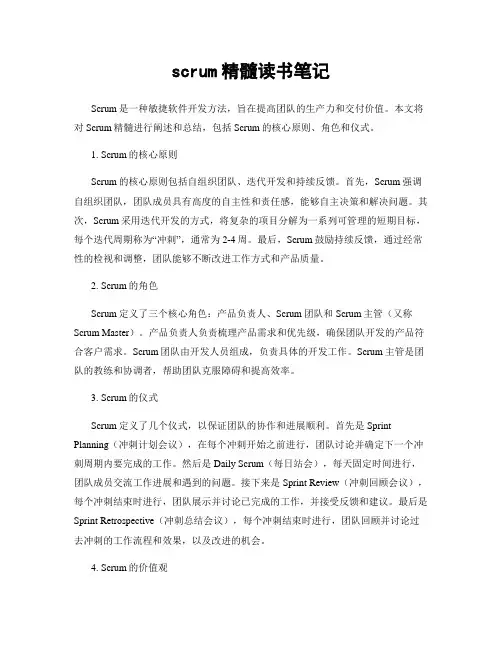
scrum精髓读书笔记Scrum是一种敏捷软件开发方法,旨在提高团队的生产力和交付价值。
本文将对Scrum精髓进行阐述和总结,包括Scrum的核心原则、角色和仪式。
1. Scrum的核心原则Scrum的核心原则包括自组织团队、迭代开发和持续反馈。
首先,Scrum强调自组织团队,团队成员具有高度的自主性和责任感,能够自主决策和解决问题。
其次,Scrum采用迭代开发的方式,将复杂的项目分解为一系列可管理的短期目标,每个迭代周期称为“冲刺”,通常为2-4周。
最后,Scrum鼓励持续反馈,通过经常性的检视和调整,团队能够不断改进工作方式和产品质量。
2. Scrum的角色Scrum定义了三个核心角色:产品负责人、Scrum团队和Scrum主管(又称Scrum Master)。
产品负责人负责梳理产品需求和优先级,确保团队开发的产品符合客户需求。
Scrum团队由开发人员组成,负责具体的开发工作。
Scrum主管是团队的教练和协调者,帮助团队克服障碍和提高效率。
3. Scrum的仪式Scrum定义了几个仪式,以保证团队的协作和进展顺利。
首先是Sprint Planning(冲刺计划会议),在每个冲刺开始之前进行,团队讨论并确定下一个冲刺周期内要完成的工作。
然后是Daily Scrum(每日站会),每天固定时间进行,团队成员交流工作进展和遇到的问题。
接下来是Sprint Review(冲刺回顾会议),每个冲刺结束时进行,团队展示并讨论已完成的工作,并接受反馈和建议。
最后是Sprint Retrospective(冲刺总结会议),每个冲刺结束时进行,团队回顾并讨论过去冲刺的工作流程和效果,以及改进的机会。
4. Scrum的价值观Scrum鼓励团队遵循一些核心价值观,包括专注、勇气、开放和尊重。
专注意味着团队成员专注于当前的任务,尽力完成工作。
勇气意味着团队成员敢于面对挑战和冲突,并提出自己的观点。
开放意味着团队成员相互之间的沟通和合作是非常重要的,他们需要分享信息、听取不同意见和反馈。
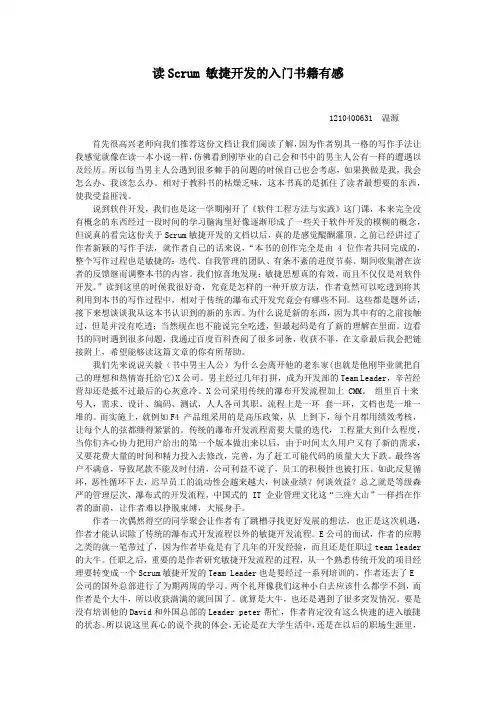
读Scrum 敏捷开发的入门书籍有感1210400631 温源首先很高兴老师向我们推荐这份文档让我们阅读了解,因为作者别具一格的写作手法让我感觉就像在读一本小说一样,仿佛看到刚毕业的自己会和书中的男主人公有一样的遭遇以及经历。
所以每当男主人公遇到很多棘手的问题的时候自己也会考虑,如果换做是我,我会怎么办、我该怎么办。
相对于教科书的枯燥乏味,这本书真的是抓住了读者最想要的东西,使我受益匪浅。
说到软件开发,我们也是这一学期刚开了《软件工程方法与实践》这门课,本来完全没有概念的东西经过一段时间的学习脑海里好像逐渐形成了一些关于软件开发的模糊的概念,但说真的看完这份关于Scrum敏捷开发的文档以后,真的是感觉醍醐灌顶。
之前已经讲过了作者新颖的写作手法,就作者自己的话来说,“本书的创作完全是由 4 位作者共同完成的,整个写作过程也是敏捷的:迭代、自我管理的团队、有条不紊的进度节奏、期间收集潜在读者的反馈继而调整本书的内容。
我们惊喜地发现:敏捷思想真的有效,而且不仅仅是对软件开发。
”读到这里的时候我很好奇,究竟是怎样的一种开放方法,作者竟然可以吃透到将其利用到本书的写作过程中,相对于传统的瀑布式开发究竟会有哪些不同。
这些都是题外话,接下来想谈谈我从这本书认识到的新的东西。
为什么说是新的东西,因为其中有的之前接触过,但是并没有吃透;当然现在也不能说完全吃透,但最起码是有了新的理解在里面。
边看书的同时遇到很多问题,我通过百度百科查阅了很多词条,收获不菲,在文章最后我会把链接附上,希望能够读这篇文章的你有所帮助。
我们先来说说关毅(书中男主人公)为什么会离开他的老东家(也就是他刚毕业就把自己的理想和热情寄托给它)X公司。
男主经过几年打拼,成为开发部的Team Leader,辛苦经营却还是抵不过最后的心灰意冷。
X公司采用传统的瀑布开发流程加上 CMM。
组里百十来号人,需求、设计、编码、测试,人人各司其职。
流程上是一环套一环,文档也是一堆一堆的。
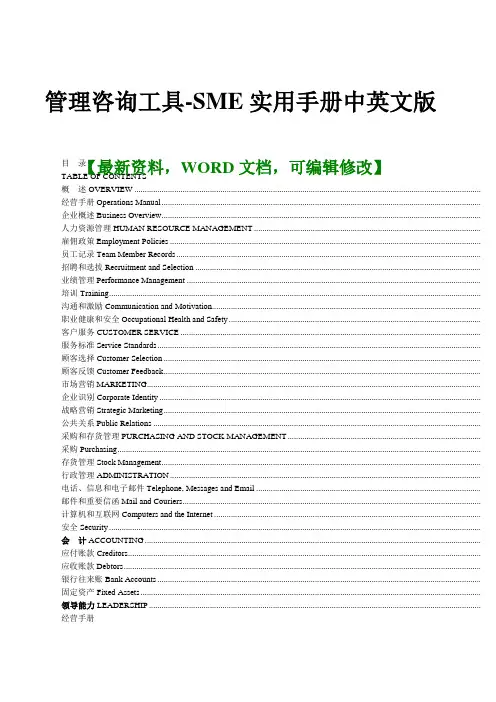
目 录TABLE OF CONTENTS 概 述OVERVIEW ..................................................................................................................................................................... 经营手册Operations Manual ........................................................................................................................................................ 企业概述Business Overview ........................................................................................................................................................ 人力资源管理HUMAN RESOURCE MANAGEMENT ............................................................................................................ 雇佣政策Employment Policies .................................................................................................................................................... 员工记录Team Member Records ................................................................................................................................................. 招聘和选拔Recruitment and Selection ........................................................................................................................................ 业绩管理Performance Management ............................................................................................................................................ 培训Training ................................................................................................................................................................................. 沟通和激励Communication and Motivation................................................................................................................................ 职业健康和安全Occupational Health and Safety ........................................................................................................................ 客户服务CUSTOMER SERVICE ............................................................................................................................................... 服务标准Service Standards .......................................................................................................................................................... 顾客选择Customer Selection ....................................................................................................................................................... 顾客反馈Customer Feedback ....................................................................................................................................................... 市场营销MARKETING ............................................................................................................................................................... 企业识别Corporate Identity ......................................................................................................................................................... 战略营销Strategic Marketing ....................................................................................................................................................... 公共关系Public Relations ............................................................................................................................................................ 采购和存货管理PURCHASING AND STOCK MANAGEMENT ............................................................................................ 采购Purchasing ............................................................................................................................................................................. 存货管理Stock Management ........................................................................................................................................................ 行政管理ADMINISTRATION .................................................................................................................................................... 电话、信息和电子邮件Telephone, Messages and Email ........................................................................................................... 邮件和重要信函Mail and Couriers .............................................................................................................................................. 计算机和互联网Computers and the Internet ............................................................................................................................... 安全Security ................................................................................................................................................................................. 会 计ACCOUNTING ................................................................................................................................................................ 应付账款Creditors ........................................................................................................................................................................ 应收账款Debtors .......................................................................................................................................................................... 银行往来账Bank Accounts .......................................................................................................................................................... 固定资产Fixed Assets .................................................................................................................................................................. 领导能力LEADERSHIP .............................................................................................................................................................. 经营手册管理咨询工具-SME 实用手册中英文版【最新资料,WORD 文档,可编辑修改】Operations Manual经营手册的目的Purpose of the Operations Manual本经营手册旨在提供必要的资源, 以帮助员工改进工作表现, 并帮助企业达成目标。
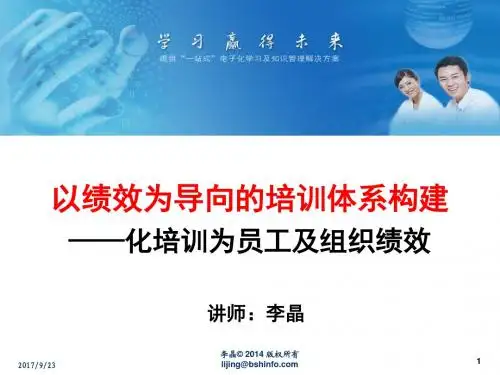
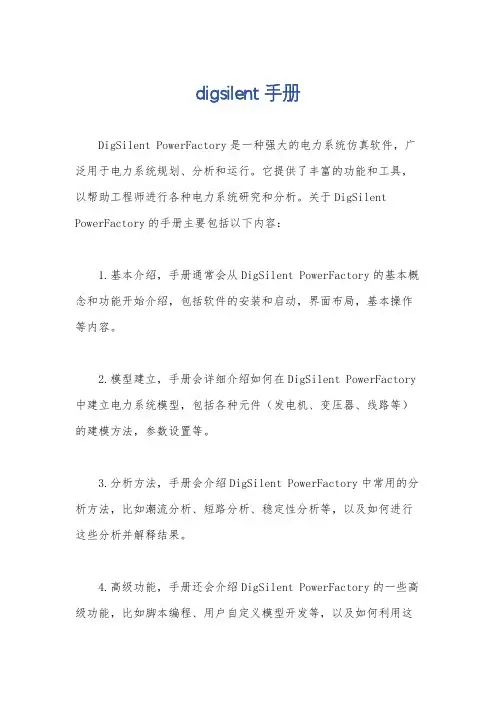
digsilent 手册
DigSilent PowerFactory是一种强大的电力系统仿真软件,广泛用于电力系统规划、分析和运行。
它提供了丰富的功能和工具,以帮助工程师进行各种电力系统研究和分析。
关于DigSilent PowerFactory的手册主要包括以下内容:
1.基本介绍,手册通常会从DigSilent PowerFactory的基本概念和功能开始介绍,包括软件的安装和启动,界面布局,基本操作等内容。
2.模型建立,手册会详细介绍如何在DigSilent PowerFactory 中建立电力系统模型,包括各种元件(发电机、变压器、线路等)的建模方法,参数设置等。
3.分析方法,手册会介绍DigSilent PowerFactory中常用的分析方法,比如潮流分析、短路分析、稳定性分析等,以及如何进行这些分析并解释结果。
4.高级功能,手册还会介绍DigSilent PowerFactory的一些高级功能,比如脚本编程、用户自定义模型开发等,以及如何利用这
些功能进行更复杂的电力系统分析。
5.案例分析,一些手册可能会包含一些案例分析,通过实际案例来演示如何使用DigSilent PowerFactory进行电力系统规划和分析。
总的来说,DigSilent PowerFactory的手册会全面详细地介绍软件的各个方面,帮助用户快速掌握软件的使用方法和技巧,从而更好地应用于实际工程中。
希望这些信息能对你有所帮助。
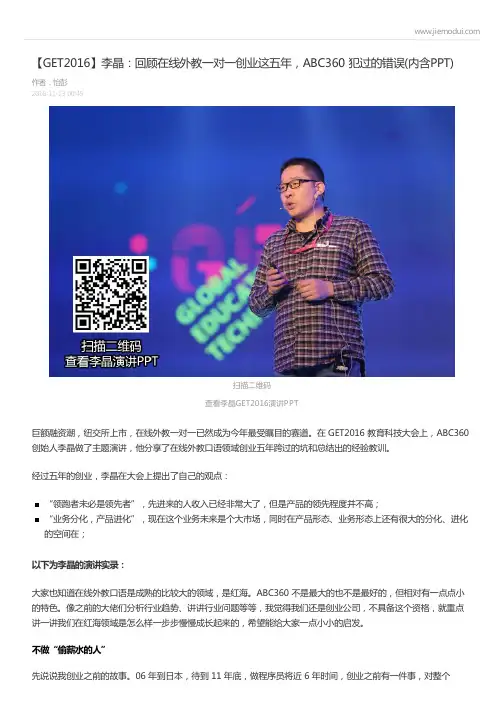
扫描二维码查看李晶GET2016演讲PPT巨额融资潮,纽交所上市,在线外教一对一已然成为今年最受瞩目的赛道。
在 GET2016 教育科技大会上,ABC360创始人李晶做了主题演讲,他分享了在线外教口语领域创业五年跨过的坑和总结出的经验教训。
经过五年的创业,李晶在大会上提出了自己的观点:“领跑者未必是领先者”,先进来的人收入已经非常大了,但是产品的领先程度并不高;“业务分化,产品进化”,现在这个业务未来是个大市场,同时在产品形态、业务形态上还有很大的分化、进化的空间在;以下为李晶的演讲实录:大家也知道在线外教口语是成熟的比较大的领域,是红海。
ABC360 不是最大的也不是最好的,但相对有一点点小的特色。
像之前的大佬们分析行业趋势、讲讲行业问题等等,我觉得我们还是创业公司,不具备这个资格,就重点讲一讲我们在红海领域是怎么样一步步慢慢成长起来的,希望能给大家一点小小的启发。
不做“偷薪水的人”先说说我创业之前的故事。
06 年到日本,待到 11 年底,做程序员将近 6 年时间,创业之前有一件事,对整个【GET2016】李晶:回顾在线外教一对一创业这五年,ABC360 犯过的错误(内含PPT)作者:怡彭2016-11-13 00:45ABC360 的企业文化有根本性的影响。
我刚到日本的时候因为日语不好、技术也一般,到了富士通里之后,领导给了一份工作 ——“看代码”。
对于一个程序员来说看代码并不是个好的任务,价值体现在写代码,不让写。
看代码看了一段时间之后,有个日本同事找我,估计看我很不爽,因为我天天看代码很轻松,他们要加班我到点回家,这个日本同事有一天中午跟我说,“日本人对待工作态度很好、很负责任,另外讲到社会各种各样的东西,比如日本乞丐都不偷东西。
”我听了觉得不错,接着他话锋一转说,“如果一个人在公司里面工作,又不给公司创造价值,他领的薪水就是偷来的。
”我听了这句话脸就红了,本身我性格也比较腼腆,这么一说我才反应过来原来是在说我,这件事对我后面在日本的五六年影响很大。
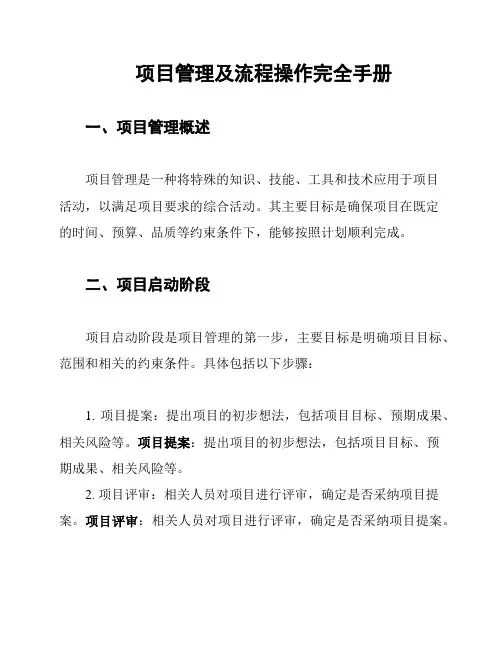
项目管理及流程操作完全手册一、项目管理概述项目管理是一种将特殊的知识、技能、工具和技术应用于项目活动,以满足项目要求的综合活动。
其主要目标是确保项目在既定的时间、预算、品质等约束条件下,能够按照计划顺利完成。
二、项目启动阶段项目启动阶段是项目管理的第一步,主要目标是明确项目目标、范围和相关的约束条件。
具体包括以下步骤:1. 项目提案:提出项目的初步想法,包括项目目标、预期成果、相关风险等。
项目提案:提出项目的初步想法,包括项目目标、预期成果、相关风险等。
2. 项目评审:相关人员对项目进行评审,确定是否采纳项目提案。
项目评审:相关人员对项目进行评审,确定是否采纳项目提案。
3. 项目启动:项目得到批准后,正式启动项目,明确项目团队和项目经理。
项目启动:项目得到批准后,正式启动项目,明确项目团队和项目经理。
三、项目规划阶段在项目启动阶段之后,项目进入规划阶段。
在这个阶段,项目经理和团队需要详细规划项目的各个方面:1. 工作分解结构(WBS):将项目的工作分解为更小、更易管理的部分。
工作分解结构(WBS):将项目的工作分解为更小、更易管理的部分。
2. 项目时间管理:确定项目的时间表,包括各个任务的开始和结束时间。
项目时间管理:确定项目的时间表,包括各个任务的开始和结束时间。
3. 项目成本管理:计划项目的预算和成本控制策略。
项目成本管理:计划项目的预算和成本控制策略。
4. 项目质量管理:设置项目的质量标准和验收条件。
项目质量管理:设置项目的质量标准和验收条件。
四、项目执行阶段项目执行阶段是项目管理的核心阶段,包括以下几个关键步骤:1. 任务分配:根据项目规划,将任务分配给项目团队的各个成员。
任务分配:根据项目规划,将任务分配给项目团队的各个成员。
2. 项目监控:项目经理需要定期监控项目的进度,确保项目按计划执行。
项目监控:项目经理需要定期监控项目的进度,确保项目按计划执行。
3. 问题处理:解决项目执行过程中出现的问题,如需求变更、资源争用等。
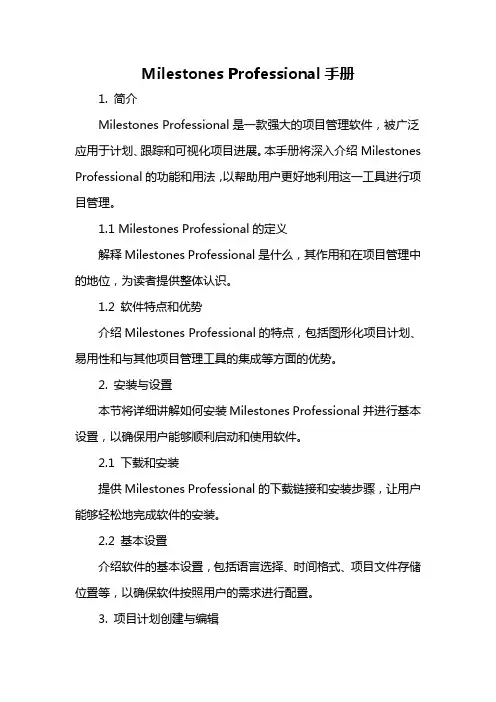
Milestones Professional手册1. 简介Milestones Professional是一款强大的项目管理软件,被广泛应用于计划、跟踪和可视化项目进展。
本手册将深入介绍Milestones Professional的功能和用法,以帮助用户更好地利用这一工具进行项目管理。
1.1 Milestones Professional的定义解释Milestones Professional是什么,其作用和在项目管理中的地位,为读者提供整体认识。
1.2 软件特点和优势介绍Milestones Professional的特点,包括图形化项目计划、易用性和与其他项目管理工具的集成等方面的优势。
2. 安装与设置本节将详细讲解如何安装Milestones Professional并进行基本设置,以确保用户能够顺利启动和使用软件。
2.1 下载和安装提供Milestones Professional的下载链接和安装步骤,让用户能够轻松地完成软件的安装。
2.2 基本设置介绍软件的基本设置,包括语言选择、时间格式、项目文件存储位置等,以确保软件按照用户的需求进行配置。
3. 项目计划创建与编辑这一部分将详细说明如何使用Milestones Professional创建和编辑项目计划,包括添加任务、调整时间轴和设置关键里程碑等。
3.1 创建新项目讲解如何在Milestones Professional中创建新的项目,设置项目基本信息和计划开始日期。
3.2 任务添加与编辑介绍如何添加任务,设置任务的起止日期、优先级等信息,并讲解如何进行任务的编辑。
3.3 时间轴调整解释如何调整项目时间轴,包括放大、缩小、移动时间轴等功能,以满足不同项目的时间要求。
4. 项目可视化与报告Milestones Professional强大的可视化功能是其一大特点,本节将详细说明如何利用这些功能制作项目图表和报告。
4.1 甘特图绘制介绍如何使用Milestones Professional绘制甘特图,展示项目任务的时间关系和进度。
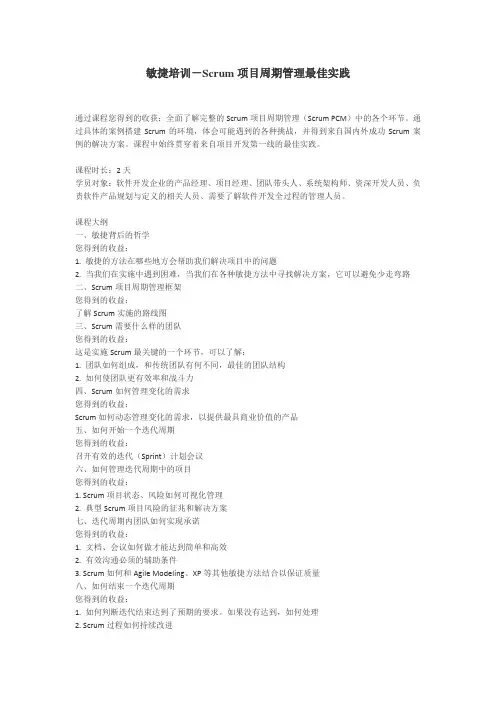
敏捷培训-Scrum项目周期管理最佳实践通过课程您得到的收获:全面了解完整的Scrum项目周期管理(Scrum PCM)中的各个环节。
通过具体的案例搭建Scrum的环境,体会可能遇到的各种挑战,并得到来自国内外成功Scrum案例的解决方案。
课程中始终贯穿着来自项目开发第一线的最佳实践。
课程时长:2天学员对象:软件开发企业的产品经理、项目经理、团队带头人、系统架构师、资深开发人员、负责软件产品规划与定义的相关人员、需要了解软件开发全过程的管理人员。
课程大纲一、敏捷背后的哲学您得到的收益:1. 敏捷的方法在哪些地方会帮助我们解决项目中的问题2. 当我们在实施中遇到困难,当我们在各种敏捷方法中寻找解决方案,它可以避免少走弯路二、Scrum项目周期管理框架您得到的收益:了解Scrum实施的路线图三、Scrum需要什么样的团队您得到的收益:这是实施Scrum最关键的一个环节,可以了解:1. 团队如何组成,和传统团队有何不同,最佳的团队结构2. 如何使团队更有效率和战斗力四、Scrum如何管理变化的需求您得到的收益:Scrum如何动态管理变化的需求,以提供最具商业价值的产品五、如何开始一个迭代周期您得到的收益:召开有效的迭代(Sprint)计划会议六、如何管理迭代周期中的项目您得到的收益:1. Scrum项目状态、风险如何可视化管理2. 典型Scrum项目风险的征兆和解决方案七、迭代周期内团队如何实现承诺您得到的收益:1. 文档、会议如何做才能达到简单和高效2. 有效沟通必须的辅助条件3. Scrum如何和Agile Modeling、XP等其他敏捷方法结合以保证质量八、如何结束一个迭代周期您得到的收益:1. 如何判断迭代结束达到了预期的要求。
如果没有达到,如何处理2. Scrum过程如何持续改进九、让我们搭建自己的Scrum您得到的收益:1. 所有课堂成员通过角色扮演体验Scrum的整个过程,把学到的知识变成可以实际应用的技能2. 了解业界Scrum开发的推荐模式十、Scrum实施的常见问题您得到的收益:了解到Scrum实施过程中普遍遇到的问题及解决方案,例如如何改良绩效考核以激励Scrum团队、QA在Scrum团队中如何工作等等十一、大型团队如何应用Scrum您得到的收益:大型团队应用Scrum的两种典型框架。
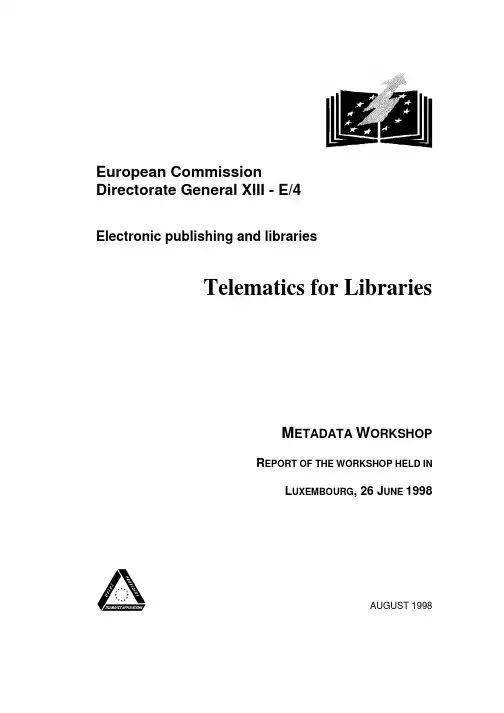
DG XIII – E/4 Second Metadata Workshop, 26 June 1998Table of contentsEXECUTIVE SUMMARY (2)1. INTRODUCTION (4)2. SPECIFIC OBJECTIVES OF THE SECOND WORKSHOP (5)3. PARTICIPATION (6)4. STRUCTURE OF THE WORKSHOP (6)5. MORNING SESSION: TECHNICAL ISSUES (6)6. AFTERNOON SESSION: STRATEGIC ISSUES (8)7. CONCLUSIONS (8)8. LIST OF ACRONYMS AND REFERENCES (9)APPENDIX 1. PROGRAMME (13)APPENDIX 2. PRESENTATIONS (14)APPENDIX 3. LIST OF PARTICIPANTS (44)DG XIII – E/4 Second Metadata Workshop, 26 June 1998E XECUTIVE SUMMARYOn 26 June 1998, the second workshop of a series on the subject of metadata organised by the European Commission DGXIII/E4 took place in Luxembourg.32 participants attended the workshop. Many organisations in Europe involved in the implementation of metadata for electronic resources were represented, as were several European Commission services.The workshop contained one session on technical and implementation issues and one session on strategic and standardisation issues reflecting the specific objectives of the workshop.The first specific objective was to give a number of projects the opportunity to present results in the area of metadata from various perspectives. In the morning session, the issues that were covered in the presentations were:metadata creation toolsdefinition of local extensions to Dublin Core for specific application areasthe use of controlled vocabularymultilingual metadataThe presenters of these subjects conducted a panel discussion on these issues and others raised by the audience.The second specific objective was to discuss metadata in a broader context with project participants and experts involved in definition and standardisation of metadata elements. In the afternoon session, presentations covered:metadata activities in contextfuture developments in Dublin CoreIn a plenary discussion, the participants discussed strategic issues concerning the definition and standardisation of metadata element sets.The major conclusions of the workshop can be summarised as follows:the strategic discussions highlighted that establishing widely accepted agreements is essential for the success of metadata;it is necessary that consensus on agreements for metadata is achieved across domains (e.g. libraries, museums, education, business, etc.);agreements and standards need to be maintained over time in a clear and open way with participation of all interested parties (especially user communities) to guarantee stability over time;formal and informal bodies involved in the standardisation of metadata sets (Dublin Core community, CEN, ISO) need to find effective ways of co-operation to ensure maximum acceptance of agreements and to avoid overlapping activities; further metadata workshops organised by the European Commission are considered to be valuable platforms for co-ordination and exchange of experience.DG XIII – E/4 Second Metadata Workshop, 26 June 1998 For further information, including PowerPoint presentations, see the Workshop’s Web site at: http://www2.echo.lu/libraries/en/metadata2.htmlFor more information on the Libraries sector of the Telematics Application Programme, see: http://www2.echo.lu/libraries/en/libraries.htmlDG XIII – E/4 Second Metadata Workshop, 26 June 19981.I NTRODUCTIONThis document is the report of the second Workshop on Metadata, held in Luxembourg on 26 June 1998.DGXIII/E4, the Electronic publishing and libraries unit, is organising a series of workshops on the issue of metadata. Intended participation is from libraries sector projects within the Telematics Applications Programme and from projects in other TAP sectors and other programmes, both EU and national. The primary objectives of the workshops are:To establish a platform for co-ordination between projects concerned with metadata in a broad sense.Under the current Framework Programme for RTD there are a number of projects concerned with metadata as such or with descriptions and descriptors of electronic documents. These projects will come across the same issues and problems and will benefit from concertation, as this will allow them to compare their concepts and approaches with others.To make a wider European community aware of developments in the standards arena and stimulate feedback from the projects to the standards.Developments in metadata in the Internet, specifically in Dublin Core, are moving fast. Some European organisations invest in participating in the Dublin Core workshops but not all have easy access to this activity. By inviting Dublin Core workshop participants to present the developments in the proposed workshops, a wider European audience can be informed on this subject. At the same time, models and experiences from the projects can be fed back into the standards arena.The first workshop which took place on 1 and 2 December 1997, contained a tutorial, project presentations, breakout sessions discussing various aspects of metadata creation and usage.The workshop, although recognising the usefulness of Dublin Core as a starting point in metadata descriptive standards, brought forward a number of concerns regarding the current state and the further development of Dublin Core:•There is currently no formal responsibility for the maintenance of Dublin Core: development takes place in an informal group of invited experts which meets once or twice per year in what is known as the Dublin Core Workshop Series.•The current technical state of Dublin Core is unstable: during the meetings of the Dublin Core group, changes are being made to the format and there is no convergence to a stable version.•The use of the current Dublin Core metadata format is not supported by the existence of guidelines: some of the philosophy and terminology of Dublin Core isDG XIII – E/4 Second Metadata Workshop, 26 June 1998 not obvious to the uninitiated user which could lead to different interpretations adversely affecting interoperability.It was also identified that the current take-up of Dublin Core is slow and that there is a lack of critical mass. This seems to be a classical chicken-and-egg situation: authors and publishers do not invest in providing Dublin Core metadata if the Internet indexing services (the ‘harvesters’) do not utilise it, and harvesters do not collect Dublin Core and use it for selective indexing if there is not enough data available. If this situation cannot be changed, Dublin Core might not turn into reality.The workshop identified a number of actions that could be taken to promote and encourage the use of Dublin Core, including the following:1.There needs to be clarity about version control and maintenance of Dublin Core.The Dublin Core group, addressed through the mailing list META2, will be asked to give a clear statement about this.2.Further pilot projects should be started to further develop experience, test out theissues and help realise a critical mass of Dublin Core metadata. The European Commission and national bodies like National Libraries might have a role to play by encouraging the provision of Dublin Core metadata in documents, e.g. in project deliverables and electronic documents in the national deposit.3.The interest and requirements existing in Europe warrant the establishment of aEuropean group of implementers discussing the practical issues of implementing metadata in general and Dublin Core in particular. The Luxembourg workshops, such as this December 1997 one and a second one scheduled for mid-1998, could develop into a regular series.4.The liaison with other groups concerned with metadata, such as the CEN/ISSSworking group on Metadata for Multimedia Information (MMI), should be established to ensure applicability and interoperability of metadata as widely as possible and cover the needs of a wide range of communities.The report of the first workshop is available on the Web at http://www2.echo.lu/libraries/en/metadata.html.2.S PECIFIC OBJECTIVES OF THE SECOND WORKSHOPThe specific objectives of this second workshop, held in Luxembourg on 26 June 1998, were as follows.The first specific objective of the second workshop was to give a number of projects the opportunity to present results in the area of metadata from various perspectives. In the morning session, the issues that were covered in the presentations were:•metadata creation tools•definition of local extensions to Dublin Core for specific application areasDG XIII – E/4 Second Metadata Workshop, 26 June 1998•the use of controlled vocabulary•multilingual metadataThe presenters of these subjects conducted a panel discussion on these issues and others raised by the audience.The second specific objective was to discuss metadata in a broader context with project participants and experts involved in definition and standardisation of metadata elements. In the afternoon session, presentations covered:•metadata activities in context•future developments in Dublin CoreIn a plenary discussion, the participants discussed strategic issues concerning the definition and standardisation of metadata element sets.The programme of the workshop is attached in Appendix 1. Printouts of the presentation, with short biographical notes of the presenters are attached in appendix 2.3.P ARTICIPATION32 persons representing projects from the Telematics programme, national projects and various Commission services attended the workshop.The list of participants is attached as appendix 3.4.S TRUCTURE OF THE WORKSHOPThis second workshop was organised on a single day and contained two sessions: one session on technical and implementation issues and one session on strategic and standardisation issues reflecting the specific objectives of the workshop.5.M ORNING SESSION: TECHNICAL ISSUESIn the first presentation, Anna B RÜMMER of Lund University in Sweden demonstrated metadata creation software constructed for the Nordic Metadata Project. This creation software on the Web offers an easy way to attach descriptive metadata to resources and has helped to build the SweMeta Dublin Core Database for Sweden, which contains 110.000 records. The system also allows users to assign a unique URN to their resource. Currently there is no statistical information on the use of the various elements, which could provide interesting information. There is no validation of the terms entered. This could be considered in the future.Erik D UVAL of Leuven University in Belgium presented the Ariadne project aiming at sharing and re-use of pedagogical resources to make the best use of scarce high-quality material for educational purposes. The project provides authoring tools that produce base metadata, which helps in creating a corpus of consistent descriptions. The project constitutes a closed environment for the participants, allowing a strongDG XIII – E/4 Second Metadata Workshop, 26 June 1998 exercise of editorial control and therefore of quality. Furthermore, users have the possibility to add annotations to the descriptions. A “Replicator Scheme” controls the distribution and access to the resources available in the Central Pool and the Local Pools in various places around Europe. The project has not reached the stage where a critical mass of material is available and is looking for further participants. The Ariadne project is co-operating with the IMS (Instructional Management Systems) project to co-ordinate the metadata definitions and agree a common metadata set. This set is not technically speaking Dublin Core as it has a richer structure and contains elements specific to educational use of the resources, but the mapping of Dublin Core into the Ariadne metadata set is considered to be possible. Also the project participates in the work in the IEEE Learning Technology Standards Committee which develops technical Standards, Recommended Practices, and Guides for software components, tools, technologies and design methods that facilitate the development, deployment, maintenance and interoperation of computer implementations of education and training components and systems.Paul M ILLER of the Archaeology Data Service in the UK introduced the advantages of using controlled vocabularies and thesauri. For users, these tools would help gaining more effective access to resources and reduce the number of false hits. Creators would be able to make more consistent descriptions and achieve a better integration of new and existing resources. It was noted that a major factor for the use of controlled vocabulary is the ease with which it can be used in both the process of creation of metadata and in the process of searching.Matthew S TIFF of the Museum Documentation Association in the UK spoke about multilingual aspects of information retrieval. He discussed the creation of parallel metadata in multiple languages versus the use of translation tools and multilingual thesauri. He identified the need for new tools but also noted these tools will be expensive and will take a lot of time to develop. Various options can be explored to create multilingual thesauri, including linking existing monolingual ones and translating one thesaurus in multiple languages. He touched upon the fundamental issue of incomplete equivalence of terms in different languages. Project Term-IT is investigating mechanisms to facilitate the production and dissemination of multilingual thesauri in the cultural sector through establishing dialogue with users and analysis of the economics of thesaurus production.As a conclusion of the technical session it was identified that:quality is a crucial issue both in the creation of metadata and in its maintenance there should be a clear focus on the user when designing tools to help create and use metadata; user communities should be actively involved to make sure their requirements are taken into accountspecial attention must be given to the change in concepts and terminologies over time.DG XIII – E/4 Second Metadata Workshop, 26 June 19986.A FTERNOON SESSION: STRATEGIC ISSUESThe first presentation in the afternoon session was delivered by Ian C AMPBELL-G RANT of ICL, chairman of the CEN/ISSS Workshop on Metadata for Multimedia Information. He introduced the work of this group as part of a new approach to standardisation especially intended to achieve rapid agreements on standards and a wide acceptance n the market. The specific objectives of the group include to gather information on metadata activities, to identify gaps and overlaps in current work and to disseminate this information to European industry, projects and programmes. The group is currently working to establish a framework that will help to find existing activities in the area of metadata definition.In the final presentation, Stuart W EIBEL of OCLC in the US presented the current state and the future prospects for the Dublin Core metadata initiative. He outlined the objectives of the initiative, noting that it is a simple set for descriptive elements that are relevant for resource discovery. It could be used as a cross-domain “switching”language, working together with other sets in the framework provided by RDF. He presented the current thinking on the issue of more formally standardising Dublin Core, working through any body that would be appropriate for that purpose (IETF, ISO, NISO, CEN/ISSS).In the discussion that took place after the presentations, several aspects were identified:the involvement of user communities and business areas is crucial to make sure their requirements are being taken into accountagain the issue of critical mass was raised: Dublin Core and other structured metadata forms an ‘island in the sea of marked data’. There needs to be more metadata before it can produce benefits to the users.the CEN/ISSS workshop could form an appropriate platform for rapid standardisation of Dublin Core in the form of a CEN Workshop Agreement; this needs to be further explored.the issue of maintenance of metadata standards is very important. The mechanism and structure should allow open and international participation to ensure the widest possible and agreement7.C ONCLUSIONSThe major conclusions of the workshop can be summarised as follows:the strategic discussions highlighted that establishing widely accepted agreements is essential for the success of metadata;it is necessary that consensus on agreements for metadata is achieved across domains (e.g. libraries, museums, education, business, etc.);agreements and standards need to be maintained over time in a clear and open way with participation of all interested parties (especially user communities) to guarantee stability over time;DG XIII – E/4 Second Metadata Workshop, 26 June 1998formal and informal bodies involved in the standardisation of metadata sets (Dublin Core community, CEN, ISO) need to find effective ways of co-operation to ensure maximum acceptance of agreements and to avoid overlapping activities; further metadata workshops organised by the European Commission are considered to be valuable platforms for co-ordination and exchange of experience.8.L IST OF ACRONYMS AND REFERENCESACM the Association for Computing Machinery, an internationalscientific and educational organization dedicated to advancingthe arts, sciences, and applications of information technology.ADS Archaeology Data Service./ahds/AHDS Arts and Humanities Data Service./ALA American Library Association./ALCTS /ccda/Ariadne RTD project under the "Telematics for Education andTraining" sector of the 4th Framework Programme of theEuropean Union. The project focuses on the development oftools and methodologies for producing, managing and reusingcomputer-based pedagogical elements and telematicssupported training curricula.http://ariadne.unil.ch/CEN European Committee for Standardisation.http://www.cenorm.be/CEN/ISSS European Committee for Standardisation - InformationSociety Standardisation System.http://www.cenorm.be/isss/default.htmCIDOC The International Committee for Documentation of theInternational Council of Museums (ICOM), the internationalfocus for the documentation interests of museums and similarorganisations./CIMI Consortium for the Computer Interchange of MuseumInformation./CPA Commission on Preservation and Access./programs/cpa/cpa.htmlDC Acronym for Dublin CoreDesire Telematics for Research project addressing the needs ofresearch users in the context of a European informationnetwork based on the World Wide Web (WWW).http://www.surfnet.nl/surfnet/projects/desire/DG XIII Directorate General XIII of the European Commission.http://europa.eu.int/en/comm/dg13/13home.htm. See also:http://www2.echo.lu/home.htmlDublin Core Dublin Core is a 15-element metadata element set intended tofacilitate discovery of electronic resources./metadata/dublin_core/EC European Commission.http://europa.eu.int/ERCIM The European Research Consortium for Informatics andMathematics - aims to foster collaborative work within theEuropean research community and to increase co-operationwith European industry.EULER Telematics for Libraries project aiming to provide user-oriented, integrated network based access to mathematicalpublications.http://www.emis.de/projects/EULER/ICL /ICOM The International Council of Museums, a Non-GovernmentalOrganisation (NGO) maintaining formal relations with UNESCO,devoted to the promotion and development of museums and themuseum profession at an international level./IEEE The Institute Of Electrical And Electronics Engineers, Inc., atechnical professional society with the objective to advance thetheory and practice of electrical, electronics and computerengineering and computer science.IETF The Internet Engineering Task Force, a large openinternational community of network designers, operators,vendors, and researchers concerned with the evolution of theInternet architecture and the smooth operation of theInternet.IMS Instructional Management Systems Project, an investmentmembership of academic, commercial and governmentorganisations developing a set of specifications and prototypesoftware for facilitating the growth and viability of distributedlearning on the Internet./ISO International Organisation for Standardisation.http://www.iso.ch/MDA Museum Documentation Association, body in the UK formuseum information management, supporting museums in allaspects of heritage information management including thecrucial area of Information and Communications Technology(ICT)./MIT Massachusetts Institute of Technology./MMI CEN/ISSS Workshop on Metadata for MultimediaInformation.http://www.cenorm.be/isss/Workshop/MMI/Default.htm NGDF National Geospatial Data Framework (UK)./NISO U.S. National Information Standards Organization:Nordic Metadata Scandinavian co-operation project creating basic elements of a metadata production and utilisation system:http://renki.helsinki.fi/meta/NSF National Science Foundation (US), an independent U.S.government agency responsible for promoting science andengineering through programs that invest in research andeducation projects in science and engineering./OCLC Online Computer Library Center, Inc., a non-profit, membership, library computer service and researchorganisation in Dublin, Ohio, USARDF Resource Description Framework, a specification currentlyunder development, designed to provide an infrastructure tosupport metadata across many web-based activities:/RDF/RLG Research Libraries Group.RTD Research & Technological DevelopmentSweMeta Dublin Core Database for Sweden.TAP The Telematics Applications Programme, one of theEuropean Commission's research programmes, aimed atstimulating RTD on applications of information and/orcommunications technologies in areas of general interest:http://www2.echo.lu/telematics/telehome2.htmlTEISS Telematics - European Industry Standards SupportTelematics for Libraries The Libraries sector of the Telematics Applications Programme:http://www2.echo.lu/libraries/en/libraries.htmlTerm-IT a preparatory-phase project under the Language Engineeringsector of the Telematics Applications Programme, aimed atleading to the development of methods and systems toimprove the production, dissemination and exploitation ofmultilingual terminology resources/term-it/URN Universal Resource Name:/html.charters/urn-charter.htmlA PPENDIX 1.P ROGRAMMEMETADATA WORKSHOP 26 JUNE 1998EUROFORUM Building352*5$00(09:00-09:20Welcome, registrationPatricia Manson, European Commission DG XIII/E-409:20-09:30IntroductionMakx D EKKERS, The Libraries Support Team0RUQLQJ VHVVLRQ 7HFKQLFDO LVVXHV09:30-10:00Metadata creation toolsAnna B RÜMMER, Univ. of Lund10:00-10:30Extension of Dublin Core for Educational materialErik D UVAL, Univ. of Leuven10:30-11:00Coffee break11:00-11:30Controlled vocabularyPaul M ILLER, Archaeology Data Service11:30-12:00Multilingual issuesMatthew S TIFF, Museum Documentation Association12:00-12:30Panel discussion12:30-13:30Lunch break$IWHUQRRQ VHVVLRQ 6WUDWHJLF LVVXHV13:30-14:00Metadata activities in contextIan C AMPBELL-G RANT, ICL (chair CEN/ISSS open Workshop on Metadatafor Multimedia Information)14:00-14:30Future developments in Dublin CoreStuart W EIBEL, OCLC14:30-15:00Tea break15:00-15:45Discussion15:45-16:00Wrap-up and closingAriane I LJON, Head of Unit, European Commission DG XIII/E-4A PPENDIX 2.P RESENTATIONSMetadata creation toolsAnna B RÜMMER, Univ. of LundBiographical note:Anna Brümmer is an electronic information services librarian at Lund University Library development department NetLab since the first of February 1996. She began after having finished her studies in library and information science in January 1996. Between 1996-1998 she has, among other things, been involved in the EU-project DESIRE, the Development of a European Service for Information on Research and Education. She is also involved in project EULER, European Libraries and Electronic Resources in Mathematical Sciences, integrating bibliographic databases, library online public access catalogues, electronic journals from academic publishers, online archives of pre-prints and grey literature, and indexes of mathematical Internet resources. For the time being she is the pro tem. head of NetLab.Abstract:Metadata tags are, in an end user perspective, complicated to produce. The talk presented one solution aiming to facilitate the metadata creation process (for end users): a metadata creation tool. The presentation described the issues involved in, and related to, the Dublin Core metadata creation and provided explanations on construction of DC Metadata records. The starting point was the Nordic Metadata project, which has developed basic elements of a metadata production and utilisation system, based on the Dublin Core Metadata Element Set. The result is the Nordic Metadata DC production template/creator, which was demonstrated at the workshop.The presentation included a short introduction to the web resource identifier URN (Uniform Resource Names) and an URN generator.The presentation is available on the Web at:http://www.lub.lu.se/EULER/presentations/creator.html.(one page print-out of Web page)Extension of Dublin Core for EducationalmaterialErik D UVAL, Univ. of LeuvenBiographical note:Erik Duval is a post-doctoral fellow of the National Fund for Scientific Research - Flanders and a part-time professor at the Katholieke Universiteit Leuven, Belgium. His main research areas are distributed hypermedia systems, data modelling, the application of information and communication technology in education, metadata and computer science education. He co-ordinates the development of the Knowledge Pool System for the ARIADNE project and is a member of the IEEE Computer Society, the ACM and the program committee of the WebNet Conference Series.Abstract:This presentation covered the current status of the author’s work on educational metadata. Since about two years, the ARIADNE project has developed both a structure and an infrastructure for educational metadata <http://ariadne.unil.ch>. The structure extends Dublin Core to a considerable extent and includes circa 70 data elements, grouped in 9 categories and defined over abstract data types. The infrastructure includes a tool for describing pedagogical documents and a distributed database of these documents and their descriptions, called the Knowledge Pool System. The ARIADNE results have been input in standardisation work in the Learning Object Metadata Working Group of the IEEE Learning Technology Standards Committee </p1484>.(6 pages printout of PowerPoint presentation, 6 slides to a page)(6 pages printout of PowerPoint presentation, 6 slides to a page)(6 pages printout of PowerPoint presentation, 6 slides to a page)(6 pages printout of PowerPoint presentation, 6 slides to a page)(6 pages printout of PowerPoint presentation, 6 slides to a page)(6 pages printout of PowerPoint presentation, 6 slides to a page)Controlled vocabularyPaul M ILLER, ADSBiographical note:Dr. Paul Miller is Collections Manager for the Archaeology Data Service (ADS)</>, one of five service providers comprising the Arts & Humanities Data Service (AHDS) </> in the United Kingdom.The ADS seeks to both preserve and encourage the reuse of digital archaeological data, whether by physically taking and mounting data or by working with existing organisations and technologies to facilitate distributed access mechanisms.Paul is responsible for the development of this distributed catalogue, and is closely involved with a number of evolving metadata initiatives around the world. These include the Dublin Core </metadata/dublin_core>, the UK's National Geospatial Data Framework (NGDF) </>, and the work of the Consortium for the Computer Interchange of Museum Information (CIMI) </>.Abstract:This presentation went into the problems of terminology and vocabulary, which become increasingly apparent as opportunities for cross-searching between different data sources grow. Efforts to develop controlled lists of terms have been relatively isolated in individual disciplines or geographic areas.With the current explosion in projects to provide remote access to these resources, and initiatives to link diverse resources together for the first time, new problems have arisen, namely;•divorcing of resources from the local expertise developed to support and maintain them •integrating diverse terminologies•contextualising the terminologies•providing access to the terminologiesIn conclusion, controlled terminology remains an important weapon in the information scientist's arsenal, but the new distributed world in which these terminologies are increasingly being used perhaps requires a new approach to some old problems, an approach which was explored in this paper.。
第 2 部分成品代号设定: (6)第 3 部分定价政策: (8)第 4 部分填制受订单: (8)第 5 部分受订单审核: (11)第 6 部分新增原物料: (12)第 7 部分定义材料的批量: (13)第 8 部分制成品制程规划: (14)第 9 部分定义产品BOM: (15)第 10 部分分仓存量核算: (17)第 11 部分生产需求分析: (18)第 12 部分下达采购计划: (21)第 13 部分下达生产计划: (22)第 14 部分审核生产需求分析单: (23)第 15 部分下达采购单: (23)第 16 部分审核采购单: (26)第 17 部分品质检验申请: (27)第 18 部分进货验收单: (28)第 19 部分验收退回: (28)第 20 部分进货处理: (29)第 21 部分进货退回: (32)第 22 部分采购退回: (33)第 23 部分托外加工单: (34)第 24 部分托工领料: (37)第 25 部分托工退料: (38)第 26 部分托工补料: (38)第 27 部分托工缴库检验申请: (39)第 29 部分托工验收退回: (41)第 30 部分托外加工缴回: (41)第 31 部分托工退回单: (43)第 32 部分单厂商付款: (44)第 33 部分下达制令单: (46)第 34 部分批次产生通知单: (47)第 35 部分修改生产通知单: (48)第 36 部分生产领料: (49)第 37 部分生产退料: (50)第 38 部分生产补料: (50)第 39 部分非生产领料: (51)第 40 部分非生产退料: (51)第 41 部分生产日报: (52)第 42 部分成品检验申请: (53)第 43 部分制成品检验: (54)第 44 部分检验单转异常通知单: (54)第 45 部分异常通知单: (55)第 46 部分异常重开通知单: (56)第 47 部分异常强制缴库: (57)第 49 部分异常重开制令单: (58)第 50 部分检验单转缴库单: (59)第 51 部分成品缴库单: (60)第 52 部分出库处理: (61)第 53 部分销货处理: (62)第 54 部分销货退回: (64)第 55 部分受订退回: (64)第 56 部分单客户收款: (65)第 57 部分库存调拨单: (66)第 58 部分库存调整单: (67)第 59 部分盘点库存: (68)第 60 部分材料出库成本计算: (69)第 61 部分材料出库成本计算: (70)第 62 部分归集直接材料: (71)第 63 部分归集制造费用: (72)第 64 部分结转制造费用: (73)第 65 部分人工及制费分摊: (74)第 66 部分结转产成品成本: (75)第 67 部分结转销售成本: (75)第 69 部分关帐: (77)第 1 部分新增客户档案:适应范围:对于新客户而言,在录入受订单前,必须先新增客户档案。
项目管理实操手册(全套)1. 简介本项目管理实操手册旨在提供一套全面而实用的项目管理指导,帮助项目团队在项目实施过程中更加高效和专业地实践项目管理原则和方法。
2. 项目启动阶段项目启动阶段是项目成功的关键阶段,主要包括以下任务:- 定义项目目标和范围- 制定项目计划和时间表- 确定项目团队和资源- 进行项目风险评估和管理- 编制项目启动报告3. 项目执行阶段项目执行阶段是项目实施的核心阶段,主要包括以下任务:- 分配任务和责任- 监督项目进展和资源利用- 协调项目相关方的合作与沟通- 处理项目风险和问题- 更新项目文档和报告- 确定并解决项目变更4. 项目收尾阶段项目收尾阶段是项目结束的关键阶段,主要包括以下任务:- 完成项目交付物和成果- 进行项目审计和评估- 维护项目知识库和文档存档- 与项目相关方进行会议和总结- 撰写项目结题报告5. 项目管理工具在项目管理实施过程中,可以使用一些常见的项目管理工具来提高工作效率和组织协作,例如:- 甘特图- 里程碑计划表- 项目进度表- 风险管理矩阵- 问题追踪系统6. 项目管理技巧在项目管理实操中,可以运用一些项目管理技巧来提高团队绩效和项目成功率,例如:- 清晰的沟通和协作- 灵活的变更管理- 有效的决策和问题解决- 适应性的风险管理- 持续的团队培训和发展7. 结论本项目管理实操手册提供了一套全面而实用的项目管理指导,可以帮助项目团队更加高效和专业地实践项目管理原则和方法。
通过合理运用项目管理工具和技巧,项目团队可以提高工作效率,降低风险,并确保项目的成功实施。
研发助理的工作内容
1. 实验准备工作呀,那可真是像厨师准备食材一样重要呢!你想想,不把各种器材、试剂都准备好,后面的研发怎么能顺利进行呢?比如我就经常需要仔细核对各种物品,确保一个都不能少!
2. 数据的收集和整理,这就像是在为研发的大厦搭建基石呀!不把那些零散的数据整理好,怎么构建起坚固的研发成果呢?有一次为了整理一份复杂的数据,我可真是费了好大的劲呢!
3. 协助研发人员进行实验,这就好比是骑士旁边的助手,要随时提供支援呀!当他们需要什么东西时,我就得快速递上,就像那次在关键时刻给研发大哥递上了关键的工具!
4. 参与讨论和头脑风暴,这可太有意思啦,不就像大家一起头脑大作战嘛!各自抛出想法,碰撞出火花,哇,有一次我提出的一个小点子还被采纳了呢!
5. 对实验结果的观察和记录,这简直就是研发过程的史官呀!要仔细地把每一个细节都记录下来,不容有一丝马虎,就像那次记录一个细微的变化,让后续的研发有了新的方向!
6. 档案的管理,这可不能小瞧呀,这是研发的记忆库呢!把各种资料整理得井井有条,以后查找多方便呀,记得有一次找一份很久以前的档案,还好我整理得好,一下子就找到了!
7. 与其他部门的沟通协调,就像桥梁一样连接起各个环节呀!要是沟通不好,那可就麻烦啦!有一回和生产部门协调出了点小问题,可把我急坏了!
8. 不断学习新知识新技能,这可是让自己不断成长的法宝呀!不学习怎么跟得上研发的脚步呢?就像我为了掌握一个新技能,花了好多时间去钻研!
研发助理的工作就是这么丰富多彩,又重要又有趣!每个环节都不能掉以轻心,都需要我们用心去对待呀!。